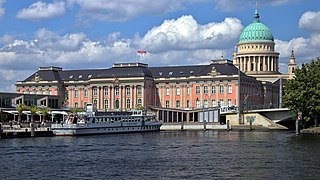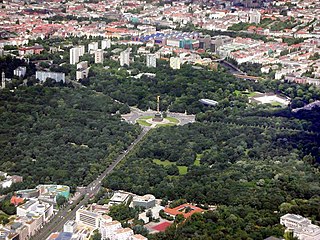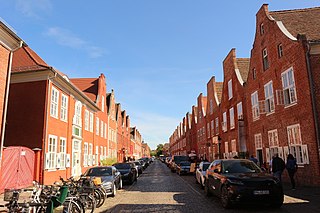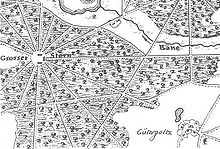
Frederick William was Elector of Brandenburg and Duke of Prussia, thus ruler of Brandenburg-Prussia, from 1640 until his death in 1688. A member of the House of Hohenzollern, he is popularly known as "the Great Elector" because of his military and political achievements. Frederick William was a staunch pillar of the Calvinist faith, associated with the rising commercial class. He saw the importance of trade and promoted it vigorously. His shrewd domestic reforms gave Prussia a strong position in the post-Westphalian political order of Northern-Central Europe, setting Prussia up for elevation from duchy to kingdom, achieved under his son and successor.

Frederick William I, known as the Soldier King, was King in Prussia and Elector of Brandenburg from 1713 till his death in 1740, as well as Prince of Neuchâtel.

Potsdam is the capital and largest city of the German state of Brandenburg. It is part of the Berlin/Brandenburg Metropolitan Region. Potsdam sits on the River Havel, a tributary of the Elbe, downstream of Berlin, and lies embedded in a hilly morainic landscape dotted with many lakes, around 20 of which are located within Potsdam's city limits. It lies some 25 kilometres southwest of Berlin's city centre. The name of the city and of many of its boroughs are of Slavic origin.

Wannsee is a locality in the southwestern Berlin borough of Steglitz-Zehlendorf, Germany. It is the westernmost locality of Berlin. In the quarter there are two lakes, the larger Großer Wannsee and the Kleiner Wannsee, located on the River Havel and separated only by the Wannsee Bridge. The larger of the two lakes covers an area of 2.7 km2 (1.0 sq mi) and has a maximum depth of 9 m (30 ft).

Carl Philipp Christian von Gontard was a German architect who worked primarily in Berlin, Potsdam, and Bayreuth in the style of late Baroque Classicism. Next to Knobelsdorff, he was considered the most important architect of the era of Frederick the Great of Prussia.

The New Palace is a palace situated on the western side of the Sanssouci park in Potsdam, Germany. The building was begun in 1763, after the end of the Seven Years' War, under King Friedrich II and was completed in 1769. It is considered to be the last great Prussian Baroque palace.

Königs Wusterhausen is a town in the Dahme-Spreewald district of the state of Brandenburg in Germany a few kilometers outside Berlin.

Lehnin Abbey is a former Cistercian monastery in Lehnin in Brandenburg, Germany. Founded in 1180 and secularized during the Protestant Reformation in 1542, it has accommodated the Luise-Henrietten-Stift, a Protestant deaconesses' house since 1911. The foundation of the monastery in the newly established Margraviate of Brandenburg was an important step in the high medieval German Ostsiedlung; today the extended Romanesque and Gothic brickstone buildings, largely restored in the 1870s, are a significant part of Brandenburg's cultural heritage.

Sanssouci is a historical building in Potsdam, near Berlin. Built by Prussian King Frederick the Great as his summer palace, it is often counted among the German rivals of Versailles. While Sanssouci is in the more intimate Rococo style and is far smaller than its French Baroque counterpart, it, too, is notable for the numerous temples and follies in the surrounding park. The palace was designed and built by Georg Wenzeslaus von Knobelsdorff between 1745 and 1747 to meet Frederick's need for a private residence where he could escape the pomp and ceremony of the royal court. The palace's name is a French phrase meaning "without worries" or "carefree", emphasising that the palace was meant as a place of relaxation rather than a seat of power.

Palaces and Parks of Potsdam and Berlin are a group of palace complexes and extended landscaped gardens located in the Havelland region around Potsdam and the German capital of Berlin. The term was used upon the designation of the cultural ensemble as a World Heritage Site by UNESCO in 1990. It was recognized for the historic unity of its landscape—a unique example of landscape design against the background of monarchic ideas of the Prussian state and common efforts of emancipation.

Jagdschloss Glienicke is a hunting lodge in the Berlin district of Wannsee near Glienicke Bridge. Babelsberg and Glienicke Palace can be seen nearby. Originally constructed in the late-17th century and expanded in the mid-1800s, the castle is part of the Palaces and Parks of Potsdam and Berlin UNESCO World Heritage Site, owing to its cohesion with the surrounding landscape and its testimony to the power of Prussia in the 17-19th centuries.

A Jagdschloss is a hunting lodge in German-speaking countries. It is a schloss set in a wildlife park or a hunting area that served primarily as accommodation for a ruler or aristocrat and his entourage while hunting in the area.

The Tiergarten, formal German name: Großer Tiergarten, is Berlin's most popular inner-city park, located completely in the district of the same name. The park is 210 hectares in size and is among the largest urban gardens of Germany. Only the Tempelhofer Park and Munich's Englischer Garten are larger.

The Dutch Quarter is a neighborhood in Potsdam, consisting of 134 red Dutch brick buildings, almost all of which have been renovated.
The Prussian Palaces and Gardens Foundation Berlin-Brandenburg was founded by a treaty of 23 August 1994 between the German federal states of Berlin and Brandenburg as a public foundation following German reunification. The treaty came into force on 1 January 1995. The foundation is separate from the considerably larger Prussian Cultural Heritage Foundation.

Park Glienicke, is an English landscape garden in the southwestern outskirts of Berlin, Germany. It is located in the locality of Wannsee in the Steglitz-Zehlendorf borough. Close to Glienicke Bridge the park is open to the general public. The park is part of the UNESCO World Heritage Site Palaces and Parks of Potsdam and Berlin. Within the ensemble it is one of the five main parks, the others being Sanssouci Park, New Garden, Babelsberg Park and Peacock Island (Pfaueninsel). Regarding diversity in gardening styles within the Potsdam park ensemble Park Glienicke is only superseded by Sanssouci Park. Furthermore, it is a park especially characterized by one personality due to the intense involvement of Prince Charles of Prussia. The park covers approximately 116 hectares

The Jagdschloss Grunewald, a hunting lodge, is the oldest preserved castle of Berlin, Germany. It is on the south waterfront of the Grunewaldsee and is part of the locality Dahlem in the borough Steglitz-Zehlendorf.

Johann Christof Merck, or Merk was a German painter who specialized in uniformed portraits and animals.

The Parforceheide between the south of Berlin and the east of Potsdam is one of the last large contiguous forest areas in the Berlin-Brandenburg metropolitan region. Although located in Brandenburg, part of the forest is owned by the state of Berlin. The basis for this was created by the permanent forest contract or century contract of 1915. An area covering around 2350 hectares has been designated as the Parforceheide landscape conservation area since 1997. One of the aims of the conservation order is to preserve "the area's function as a climatic compensation area in the south of the Berlin conurbation". The name goes back to the par force hunts for which King Frederick William I of Prussia had the Stern hunting lodge built in the forest in 1730.























